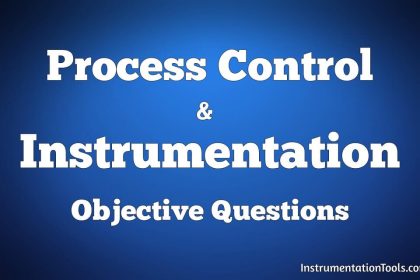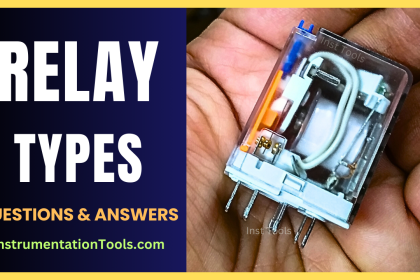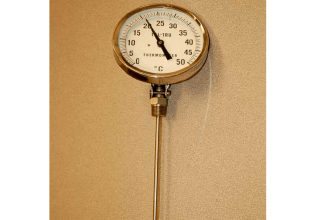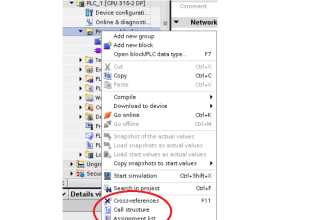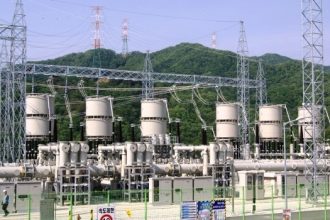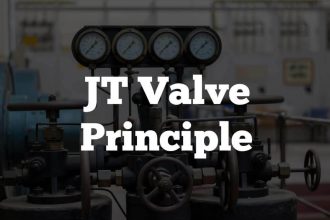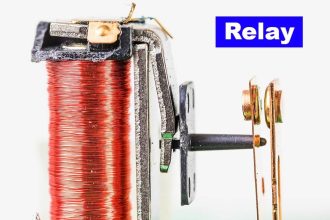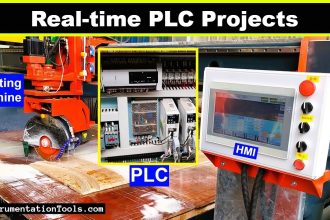Prepare for your exams with the top 50 limit switch questions and answers to learn about different types, functions, and applications.
Limit Switch Questions and Answers
The following limit switch video provides the explanations for the first 25 questions.
Question 1
What is the primary function of a limit switch?
A. To detect the presence or absence of an object without contact
B. To control motor speed in the industries
C. To limit the power supply for an equipment
D. To detect the presence or absence of an object with contact
Show the Answer
To detect the presence or absence of an object with contact
Question 2
What is the role of the actuator in a mechanical limit switch?
A. To detect magnetic fields
B. To measure temperature
C. To physically move to activate contacts
D. To generate electrical signals
Show the Answer
To physically move to activate contacts
Question 3
Which component of a mechanical limit switch houses the internal parts?
A. Terminals
B. Housing
C. Contacts
D. Actuator
Show the Answer
Housing
Question 4
What is the purpose of the return spring in a mechanical limit switch?
A. To keep the contacts open
B. To enhance electrical conductivity
C. To measure pressure
D. To reset the actuator after activation
Show the Answer
To reset the actuator after activation
Question 5
What are the contacts in a mechanical limit switch responsible for?
A. Detecting physical movement
B. Generating magnetic fields
C. Opening or closing the electrical circuit
D. Providing tactile feedback
Show the Answer
Opening or closing the electrical circuit
Question 6
Which part of a mechanical limit switch is directly moved by the object being detected?
A. Housing
B. Contacts
C. Actuator
D. Terminals
Show the Answer
Actuator
Question 7
How do the terminals function in a mechanical limit switch?
A. They reset the actuator
B. They provide connection points for wiring
C. They sense magnetic fields
D. They generate light beams
Show the Answer
They provide connection points for wiring
Question 8
What material is commonly used for the contacts in a mechanical limit switch?
A. Rubber
B. Plastic
C. Wood
D. Copper
Show the Answer
Copper
Question 9
What role does the lever play in a lever-type mechanical limit switch?
A. It measures current
B. It amplifies the motion of the actuator
C. It detects magnetic fields
D. It generates electrical signals
Show the Answer
It amplifies the motion of the actuator
Question 10
Why is the enclosure rating important for the housing of a mechanical limit switch?
A. It determines the switch’s electrical load
B. It indicates the color of the switch
C. It specifies protection against dust and water
D. It shows the switch’s weight
Show the Answer
It specifies protection against dust and water
Question 11
How does the plunger function in a plunger-type mechanical limit switch?
A. It senses changes in capacitance
B. It emits light to detect objects
C. It measures temperature
D. It moves up and down to activate the contacts
Show the Answer
It moves up and down to activate the contacts
Question 12
What ensures the mechanical limit switch returns to its original position?
A. Terminal
B. Return spring
C. Contact block
D. Actuator
Show the Answer
Return spring
Question 13
How do the mounting holes in a mechanical limit switch housing function?
A. They secure the switch in place
B. They act as ventilation points
C. They provide electrical connections
D. They allow for actuator adjustment
Show the Answer
They secure the switch in place
Question 14
What is the purpose of the cam in some mechanical limit switches?
A. To measure current flow
B. To act as a sensor for magnetic fields
C. To detect temperature changes
D. To convert rotational motion to linear motion
Show the Answer
To convert rotational motion to linear motion
Question 15
Why are roller actuators used in mechanical limit switches?
A. To increase the electrical load capacity
B. To detect changes in light intensity
C. To reduce friction and wear during actuation
D. To measure pressure differences
Show the Answer
To reduce friction and wear during actuation
Question 16
What is the role of the contact block in a mechanical limit switch?
A. It generates the magnetic field
B. It encloses the return spring
C. It houses the actuator
D. It provides the electrical connection points
Show the Answer
It provides the electrical connection points
Question 17
What type of environment poses a challenge for mechanical limit switches?
A. High-pressure
B. Dusty
C. Dark
D. Electromagnetically noisy
Show the Answer
Dusty
Question 18
Why are limit switches important in safety applications?
A. They work in any environment
B. They can detect motion
C. They can prevent machine overtravel
D. They can prevent motor over heating
Show the Answer
They can prevent machine overtravel
Question 19
What is the primary disadvantage of mechanical limit switches?
A. Complex wiring
B. Limited range
C. Susceptible to wear and tear
D. High cost
Show the Answer
Susceptible to wear and tear
Question 20
Which industry heavily relies on limit switches for safety and automation?
A. Textile
B. Automotive
C. Semiconductor
D. Food and beverage
Show the Answer
Automotive
Question 21
What kind of actuator might a mechanical limit switch use?
A. Electric pulse
B. Light beam
C. Roller lever
D. Magnetic field
Show the Answer
Roller lever
Question 22
Which component protects a limit switch from environmental hazards?
A. Actuator
B. Wiring
C. Housing
D. Contacts
Show the Answer
Housing
Question 23
In which application are limit switches crucial for ensuring operator safety?
A. Office lighting systems
B. Industrial machinery
C. Personal computers
D. Home appliances
Show the Answer
Industrial machinery
Question 24
What is the benefit of adjustable limit switches?
A. Fixed activation points
B. Permanent installation
C. Fixed detection range
D. Flexibility in setting activation points
Show the Answer
Flexibility in setting activation points
Question 25
What is the significance of the IP rating for a limit switch?
A. It shows the switch’s power rating
B. It denotes the switch’s enclosure protection
C. It indicates the switch’s color
D. It specifies the switch’s mechanical lifespan
Show the Answer
It denotes the switch’s enclosure protection
Common Questions About Limit Switch Specifications
This video provides detailed explanations about the limit switch specifications for the following questions and answers.
Question 26
What does the term “rated operational current” specify in a limit switch?
A. The maximum current the switch can handle
B. The minimum current for reliable operation
C. The maximum voltage the switch can handle
D. The current required to activate the switch
Show the Answer
The maximum current the switch can handle
Question 27
Which factor primarily affects the mechanical lifespan of a limit switch?
A. Actuator type
B. Contact material
C. Operating environment
D. Voltage rating
Show the Answer
Operating environment
Question 28
What does the “actuation force” specification refer to in a limit switch?
A. The force exerted by the contacts
B. The electrical force applied by the switch
C. The force needed to operate the actuator
D. The mechanical strength of the housing
Show the Answer
The force needed to operate the actuator
Question 29
How is the “contact resistance” specification important for a limit switch?
A. It impacts the switch’s electrical performance
B. It influences the switch’s actuation speed
C. It determines the switch’s size
D. It affects the switch’s sensitivity
Show the Answer
It impacts the switch’s electrical performance
Question 30
What does the “pretravel” specification indicate in a limit switch?
A. The time it takes for the switch to reset
B. The force required to activate the switch
C. The distance the actuator must move before contacts close
D. The switch’s lifespan
Show the Answer
The distance the actuator must move before contacts close
Question 31
Why is the “differential travel” specification crucial in limit switches?
A. It controls the switch’s lifespan
B. It maintains contact reliability
C. It ensures consistent actuation force
D. It prevents accidental reset
Show the Answer
It prevents accidental reset
Question 32
What does “overtravel” specify in a limit switch?
A. The maximum voltage the switch can handle
B. The maximum current the switch can handle
C. The speed at which the switch operates
D. The additional actuator movement after activation
Show the Answer
The additional actuator movement after activation
Question 33
What does “reset point” refer to in the limit switches?
A. The position where the switch returns to its original state
B. The maximum load the switch can handle
C. The force required to reset the switch
D. The current needed to reset the switch
Show the Answer
The position where the switch returns to its original state
Question 34
What does the term “snap action” imply in limit switch specifications?
A. Gradual movement of contacts
B. Sudden movement of contacts
C. Continuous movement of contacts
D. No movement of contacts
Show the Answer
Sudden movement of contacts
Question 35
How is “switching frequency” defined in limit switch specifications?
A. Number of times a switch can operate per minute
B. The force needed for each activation
C. The duration of each switching cycle
D. The speed at which the switch activates
Show the Answer
Number of times a switch can operate per minute
Question 36
What is indicated by the “operating temperature range” of a limit switch?
A. The temperature at which the switch is installed
B. The temperature required to activate the switch
C. The maximum temperature the contacts can handle
D. The range of temperatures the switch can operate within
Show the Answer
The range of temperatures the switch can operate within
Question 37
What does “mechanical endurance” specify in a limit switch?
A. The number of mechanical cycles the switch can perform
B. The maximum load the switch can handle
C. The duration the switch can remain active
D. The force the switch can withstand
Show the Answer
The number of mechanical cycles the switch can perform
Question 38
Why is “contact material” important in limit switch specifications?
A. It determines the switch’s mechanical strength
B. It influences the switch’s electrical performance
C. It affects the switch’s weight
D. It defines the switch’s physical size
Show the Answer
It influences the switch’s electrical performance
Question 39
What does “contact configuration” describe in a limit switch?
A. The arrangement of the contacts (e.g., NO, NC)
B. The size of the contacts
C. The material of the contacts
D. The shape of the contacts
Show the Answer
The arrangement of the contacts (e.g., NO, NC)
Question 40
How does the “insulation resistance” specification affect a limit switch?
A. It influences the switch’s mechanical durability
B. It impacts the switch’s thermal stability
C. It determines the switch’s resistance to current leakage
D. It affects the switch’s physical dimensions
Show the Answer
It determines the switch’s resistance to current leakage
Question 41
What does the term “dielectric strength” refer to in limit switch specs?
A. The voltage the switch can withstand without breaking down
B. The frequency at which the switch operates
C. The force needed to activate the switch
D. The switch’s resistance to wear and tear
Show the Answer
The voltage the switch can withstand without breaking down
Question 42
Why is the “maximum switching speed” specification important for a limit switch?
A. It determines the switch’s cost
B. It influences the switch’s response time
C. It defines the switch’s contact material
D. It affects the switch’s size
Show the Answer
It influences the switch’s response time
Question 43
What does the “response time” specification indicate in a limit switch?
A. The operating lifespan of the switch
B. The time taken to reset after activation
C. The time taken to activate after actuation
D. The duration of the activation signal
Show the Answer
The time taken to activate after actuation
Question 44
How does the “resetting force” specification affect limit switch performance?
A. It determines the force needed to reset the switch
B. It affects the switch’s activation speed
C. It determines the current needed to reset the switch
D. It controls the switch’s electrical load
Show the Answer
It determines the force needed to reset the switch
Question 45
What is meant by “operating position” in limit switch specifications?
A. The installation orientation of the switch
B. The position at which the switch is actuated
C. The default state of the switch
D. The maximum movement allowed by the switch
Show the Answer
The position at which the switch is actuated
Question 46
What does the “shock resistance” specification ensure for a limit switch?
A. The switch’s capacity to handle high loads
B. The switch’s performance under vibration
C. The switch’s ability to resist electrical surges
D. The switch’s resistance to sudden impacts
Show the Answer
The switch’s resistance to sudden impacts
Question 47
What does “contact rating” specify in a limit switch?
A. The size of the contacts
B. The switch’s mechanical strength
C. The voltage and current the contacts can handle
D. The material used for the contacts
Show the Answer
The voltage and current the contacts can handle
Question 48
Which factor does the “mounting type” specification address in a limit switch?
A. The environmental protection of the switch
B. The electrical rating of the switch
C. The type of actuator used
D. The method of attaching the switch to equipment
Show the Answer
The method of attaching the switch to equipment
Question 49
What material is typically used for the contacts in a limit switch?
A. Copper
B. Plastic
C. Wood
D. Rubber
Show the Answer
Copper
Question 50
Which component of a limit switch determines its actuation force?
A. Housing
B. Wiring
C. Actuator
D. Contacts
Show the Answer
Actuator
Read Next:
- What is a Limit Switch?
- Types of Limit Switches
- PLC Limit Switch Example
- Limit Switch Animation
- How Does Limit Switch Work?



